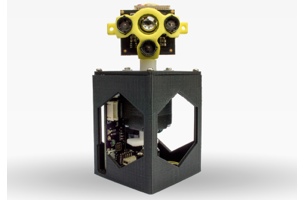Terabee is best known for their infrared time-of-flight sensors. You may remember them from Intel’s keynote at CES 2015, when the microchip giant used one of Terabee’s infrared sensors as a reactive altimeter in a demonstration of sense-and-avoid technology for drones.
The company doesn’t just work with infrared, though. It describes itself as producing the “smallest, lightest and fastest distance sensors” on the market, which means it was only a matter of time before they added a LiDAR to their offerings.
The TeraRanger LiDAR sensor is marketed as “an entry-level LiDAR scanner for short-range indoor applications such as Simultaneous Localization and Mapping (SLAM).” It is a smaller version of their infrared sensor, customized “to create a small, light and easy to use solution at an affordable price.”
Currently, it measures 75 x 44 x 44 mm with its base enclosure. It weighs 125 grams, scans at a distance of up to 7 meters, spins a full 360 degrees, and gathers a user-configurable sample density of anywhere between 200 and 1000 samples per scan. The sensor clocks in at €498.00, or approximately $540 as of this writing. Check out the full spec sheet here.
All of these numbers, including price, are likely to drop in the future. The current model of the TeraRanger LiDAR is an “early adopter” evaluation unit to be sold in limited numbers. According to the company “high volume production units and prices may differ.”
Even in its current state, the sensor is fully eye-safe and inexpensive, which makes it a good match for customers in education, research, and the maker community.
This means it is also a good match for the professional community—since many of you are also DIY types and makers always looking for ways to build your own affordable solutions for SLAM, sense-and-avoid, or even simple 2D room scanning.
If that describes you, the TeraRanger entry-level LiDAR scanner from TeraBee will come as good news.
See below for some videos of TeraBee’s other sensors in action.












